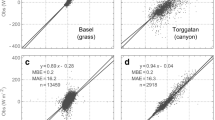Summary
Typical observations of surface energy fluxes in urban areas usually employ the eddy covariance approach with measurements from a tower at a height well above the roughness elements. Net radiation and the turbulent fluxes are directly measured, the anthropogenic flux may be estimated and the storage flux is calculated as an energy balance residual. This paper reports both measurement and modelling of energy fluxes during wintertime in suburban areas of Christchurch, New Zealand. Under settled anticyclonic conditions, a strong inversion can occur over the city which severely restricts turbulent mixing. Even after sunrise the turbulent fluxes are small, and if one assumes advection is negligible, this means the storage flux increases in importance to very high levels. This paper suggests that these high storage rates are physically unrealistic for this environment. Rather, it is likely that some energy, which is assumed to be dissipated as heat storage, is more likely lost through mesoscale advection or attributed to errors caused by unsuitable measurement techniques under conditions with low friction velocity. However, even these two processes cannot fully account for flux loss. A full study is recommended to resolve this issue and meanwhile, caution is advised when applying current research methodology to estimate storage fluxes in urban areas in stable wintertime conditions.
Similar content being viewed by others
References
Canterbury Regional Council (1997) Christchurch inventory of home heating and motor vehicle emissions. Technical Report. Environmental Management Group. Prepared by NIWA, May 1997, Report No. R97/5
JJ Finnigan R Clement Y Mahli R Leuning HA Cleugh (2003) ArticleTitleA re-evaluation of long-term flux measurement techniques. Part I: Averaging and coordinate rotation. Bound-Layer Meteor 107 1–48 Occurrence Handle10.1023/A:1021554900225
Gimson N (1998) Wintertime meteorology and air pollution dispersion in Christchurch. Canterbury Regional Council, report No. U98/58
ML Goulden BC Daube SM Fan DJ Sutton A Bazzaz JW Munger SC Wofsy (1997) ArticleTitlePhysiological response of a black spruce forest to weather. J Geophys Res 102 28987–28996 Occurrence Handle10.1029/97JD01111
ML Goulden JW Munger SM Fan BC Daube SC Wofsy (1996) ArticleTitleMeasurements of carbon sequestration by long-term eddy covariance: methods and a critical evaluation of accuracy. Glob Change Biol 2 169–182
CSB Grimmond (1992) ArticleTitleThe suburban energy balance: methodological considerations and results for a mid-latitude west coast city under winter and spring conditions. Int J Climatol 12 481–497
CSB Grimmond HA Cleugh TR Oke (1991) ArticleTitleAn objective hysteresis model for urban storage heat flux and its comparison with other schemes. Atmos Environ 25B 311–326
CSB Grimmond TS King M Roth TR Oke (1998) ArticleTitleAerodynamic roughness of urban areas derived from wind observations. Bound-Layer Meteor 89 1–24 Occurrence Handle10.1023/A:1001525622213
CSB Grimmond TR Oke (1999) ArticleTitleHeat storage in urban areas: local scale observations and evaluation of a simple model. J Appl Meteor 38 922–940
CSB Grimmond TR Oke (1995) ArticleTitleComparison of heat fluxes from summertime observations in the suburbs of four North American Cities. J Appl Meteor 34 873–889 Occurrence Handle10.1175/1520-0450(1995)034<0873:COHFFS>2.0.CO;2
ML Kerschgens RL Drauschke (1985) ArticleTitleOn the energy budget of a wintry mid-latitude city atmosphere. Beitr Phys Atmos 59 115–125
L Mahrt (1998) ArticleTitleStratified atmospheric boundary layers. Bound-Layer Meteor 90 375–396
L Mahrt D Vickers R Nakamura MR Soler (2001) ArticleTitleShallow drainage flows. Bound-Layer Meteor 101 243–260 Occurrence Handle10.1023/A:1019273314378
WJ Massman X Lee (2002) ArticleTitleEddy covariance flux corrections and uncertainties in long-term studies of carbon and energy exchanges. Agric Forest Meteorol 113 121–144 Occurrence Handle10.1016/S0168-1923(02)00105-3
IG McKendry AP Sturman IF Owens (1986) ArticleTitleA study of interacting multiscale wind systems, Canterbury Plains, New Zealand. Meteorol Atmos Phys 35 242–252 Occurrence Handle10.1007/BF01041817
Oke TR (1987) Boundary layer climates. London: Methuen
TR Oke (1988) ArticleTitleThe urban energy balance. Prog Phys Geog 12 471–508
MR Raupach (1994) ArticleTitleSimplified expressions for vegetation roughness length and zero-plane displacement as a function of canopy height and area index. Bound-Layer Meteor 71 211–216 Occurrence Handle10.1007/BF00709229
M Roth TR Oke (1994) ArticleTitleComparison of modelled and ‘measured’ heat storage in suburban terrain. Beitr Phys Atmos 67 149–156
HP Schmid (1997) ArticleTitleExperimental design for flux measurements: matching scales of observations and fluxes. Agric Forest Meteorol 87 179–200 Occurrence Handle10.1016/S0168-1923(97)00011-7
HP Schmid (1994) ArticleTitleSource areas for scalars and scalar fluxes. Bound-Layer Meteor 67 293–318 Occurrence Handle10.1007/BF00713146
HP Schmid HA Cleugh CSB Grimmond TR Oke (1991) ArticleTitleSpatial variability of energy fluxes in suburban terrain. Bound-Layer Meteor 54 249–276 Occurrence Handle10.1007/BF00183956
RA Spronken-Smith (2002) ArticleTitleComparison of summer- and winter-time suburban energy fluxes in Christchurch, New Zealand. Int J Climatol 22 979–992 Occurrence Handle10.1002/joc.767
Spronken-Smith RA, Sturman A, Kossmann M, Zawar-Reza P (2002) An overview of the Christchurch Air Pollution Study (CAPS) 2000. Proceed. 16th Int. Clean Air and Environment Conference of the Clean Air Society of Australia & New Zealand, 19–22 August 2002, Christchurch, New Zealand on CD ROM
Stull RB (1988) An introduction to boundary layer meteorology. Dordrecht: Kluwer Academic Publications
Tanner BD, Greene JP (1989) Measurements of sensible heat and water vapour fluxes using eddy correlation methods. Final Report to US Army Dugway Proving Grounds
NJ Tapper PD Tyson IF Owens WJ Hastie (1981) ArticleTitleModelling the winter urban heat island over Christchurch, New Zealand. J Appl Meteor 20 365–376
EK Webb GI Pearman R Leuning (1980) ArticleTitleCorrection of flux measurements for density effects due to heat and water vapour transfer. Quart J Roy Meteor Soc 106 85–100 Occurrence Handle10.1256/smsqj.44706
JM White FD Eaton AH Auer (1978) ArticleTitleThe net radiation budget of the St. Louis metropolitan area. J Appl Meteor 17 593–599 Occurrence Handle10.1175/1520-0450(1978)017<0593:TNRBOT>2.0.CO;2
CD Whiteman JM Hubbe WJ Shaw (2000) ArticleTitleEvaluation of inexpensive temperature data logger for meteorological applications. J Atmos Oceanic Technol 17 77–81 Occurrence Handle10.1175/1520-0426(2000)017<0077:EOAITD>2.0.CO;2
Author information
Authors and Affiliations
Rights and permissions
About this article
Cite this article
Spronken-Smith, R., Kossmann, M. & Zawar-Reza, P. Where does all the energy go? Surface energy partitioning in suburban Christchurch under stable wintertime conditions. Theor. Appl. Climatol. 84, 137–149 (2006). https://doi.org/10.1007/s00704-005-0151-2
Received:
Revised:
Accepted:
Published:
Issue Date:
DOI: https://doi.org/10.1007/s00704-005-0151-2




